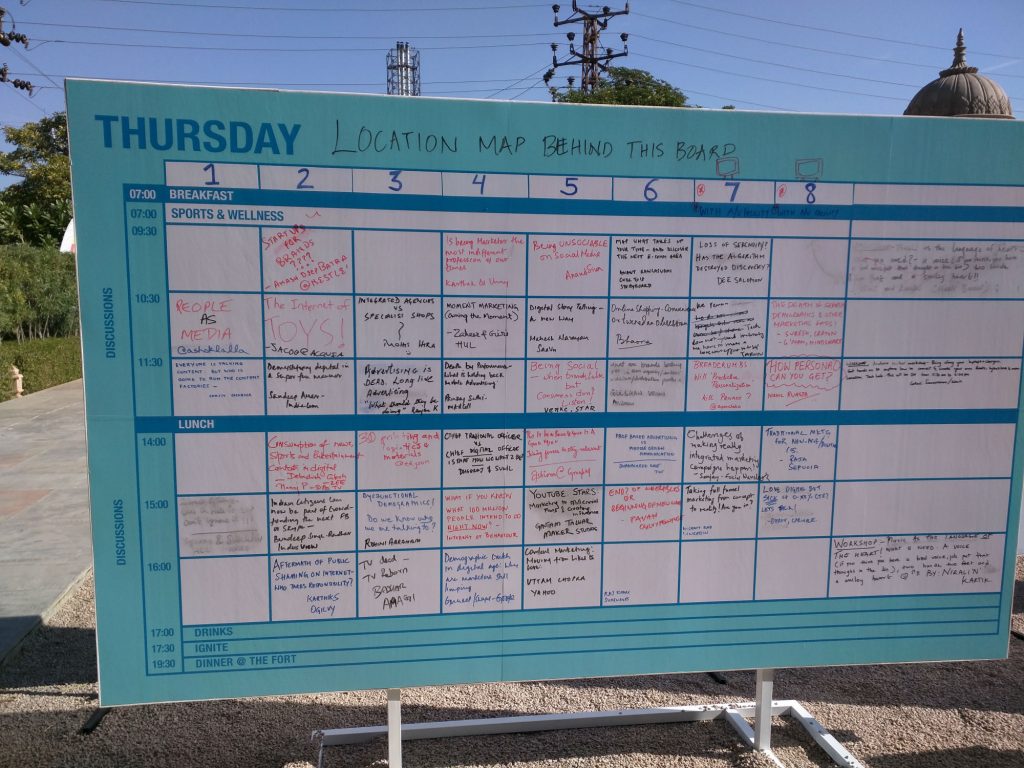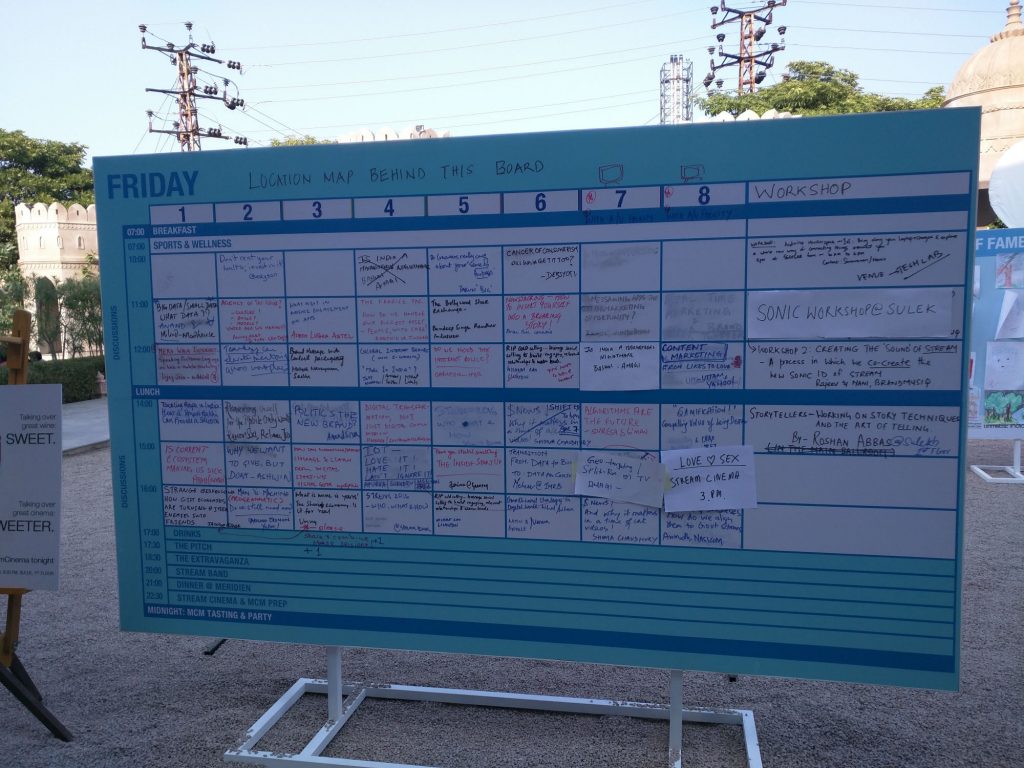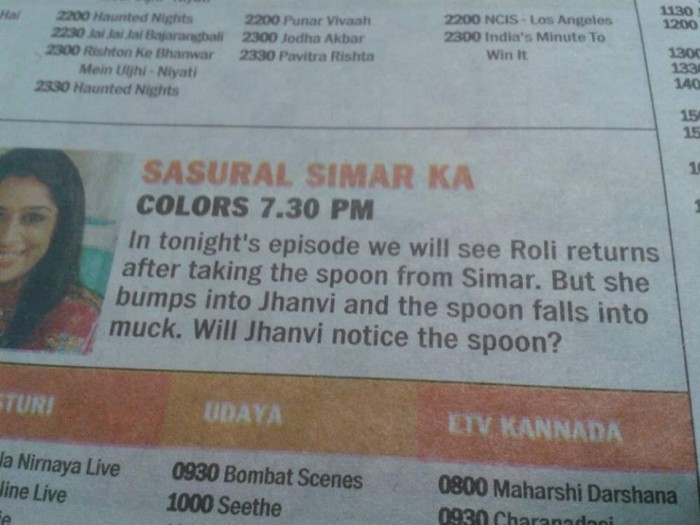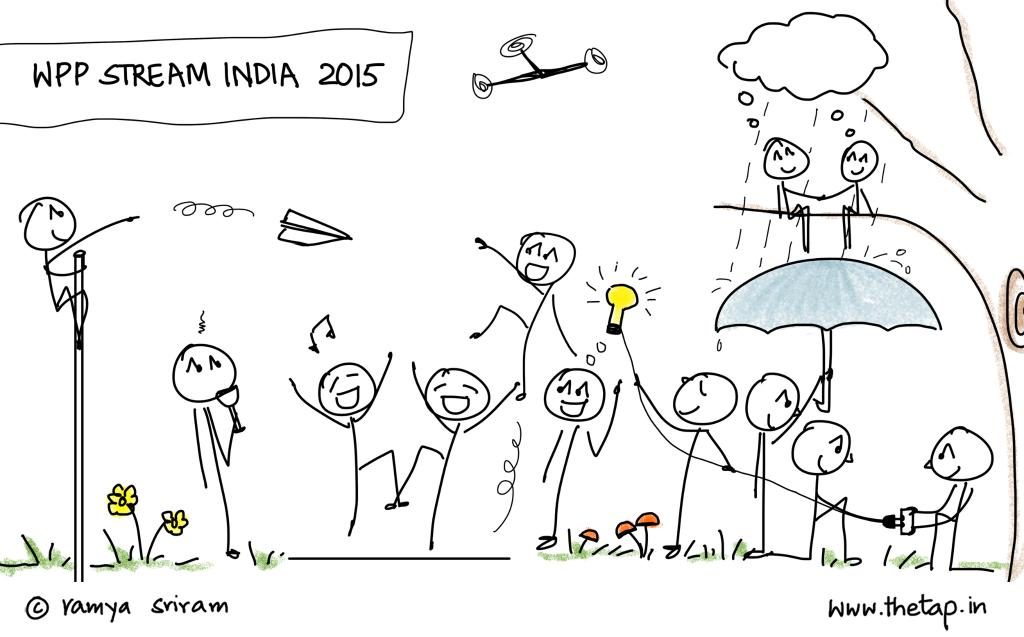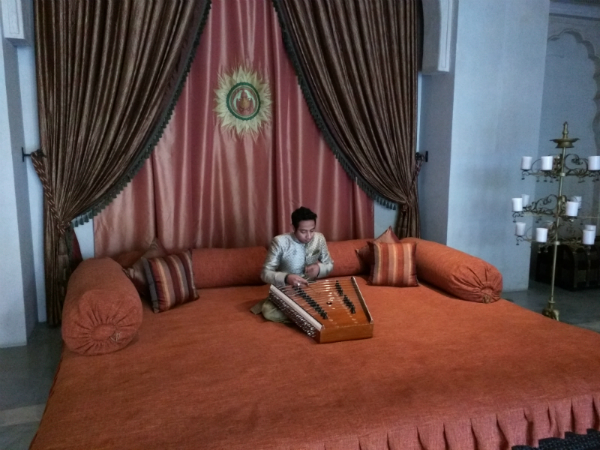
Stream India 2015 is my first unconference experience. The format is mighty interesting and untethering! Participants are asked to jot down their topics on a board and given the limited slots available for discussions (48 slots per day; 8 concurrent sessions, across 6 one-hour slots), people need to make up their mind and list their topics fast.
Discussions on Day 1 (click on image for larger view)
Discussions on Day 2 (click on image for larger view)
The surprising – and best – part was that most of the sessions were completely non-pluggy, or, non-sales pitch’y! The topics were pretty diverse and covered a whole spectrum of themes across digital, social media, branding, news media and advertising, among others.
The sessions took place in a large’ish lawn area at the Fairmont Hotel and it was possible to stream in and out of sessions (that’s why the name, Stream? 🙂 ).
That level of fluidity was perhaps a problem since some sessions did not have enough quorum, despite having interesting themes to discuss. While I do not suggest having sessions in separate, confined areas, it may be useful to limit the number of participants per session (like limiting the number of sessions itself – 48 per day) so that people realize a couple of things,
- that the session leads have done a good deal of homework on their topics and that needs to be respected. Empty sessions or sessions with 3-4 people may seem demotivating. For example, I was looking forward to ‘Do we need the internet police?’ discussion by Hungama’s Carlton D’Silva (Twitter | LinkedIn), but perhaps owing to the timing (Day 2, 12 noon) or something else (people prepping for The Pitch etc.), he had to abandon it due to lack of quorum.
- at a simple, logisticial level, it became difficult, in that open space, to listen to many speakers/participants (thanks also to some kind of construction work happening at the hotel, in the background).
So, having smaller, closed groups may help in every session getting a basic audience and also every participant getting a chance to actively take part in the discussions.
Considering the number of participants in 2015 – about 250 – that may mean limiting the participants per session to around 30. Such limiting should not be strictly enforced, of course, given the open nature of the event, but may be suggested in more subtle ways… for example, setting only 30 chairs in each session venue and making requests around that too, at the beginning.
I was part of a few sessions and led one too.
Some broad takeaways from the sessions I attended.
1. Map what takes up your time and discover the next e-commerce idea – Anant Rangaswami (Twitter | LinkedIn)
The core premise of this session was very, very interesting. Anant broke down all e-commerce concepts down to time, which in a way is accurate, though we see e-comm benefits under various parameters like convenience, variety, price etc.
For example, convenience may mean I get to order weekly groceries instead of heading out to a store nearby. That saves me the hassle of driving out and eventually saves me that time.
Variety may mean, instead of walking up and down 10 stores to buy a pair of shoes, I may spend lesser time browsing 100 web pages and making up my mind. Again – time. And hassle, of course.
I had a fundamental issue with calculating everything based on time – do we really value our time so much, at that level that when presented with an option to cut it down, do we think, ‘Oh wow, I’ll save 30 minutes by doing this online, let me read a book in that time!’.
As I spoke my mind out, this is a great pitch for a segment that seriously has a paucity of time, consistently, day after day. Say, CEO-types, who live their life by the calendar/clock. Imagine, pitching them the idea of a time-bound, personalized, home-service barber or a tailor. It would no doubt come at a premium, but, for this target segment, that premium may be easily explained and deserved too.
As Anant himself agreed, this is a thought starter to see e-commerce in a newer way – from the prism of things that we can save time on, by performing them online and filling those gaps via e-commerce.
Some of the other ideas tossed around included a service to connect tutors and students (tutors of any kind, even teaching one recipe at home; students of any kind, age-agnostic). That’s an interesting concept that is perhaps happening at an informal, rudimentary level via Whatsapp and Facebook. An aggregator that helps people search based on location and kind of service is indeed a good idea.
Another point Anant made was around scaling in internet businesses. He asked, ‘Why can’t a bakery aim to be the best in Besant Nagar alone? Why should they also aim to be best in Chennai and best in India?’. This is an interesting question. E-commerce is always associated with scale economies, but I’d like to take the example of an e-commerce service we (I, my wife and a lot of people in Bangalore) swear by – Town Essentials. It’s an online grocery and fresh vegetables/fruits store and has a relatively unglamorous website (compared to ZopNow or BigBasket, for example). I got to know about it from a few friends on Twitter and I had great difficulty in convincing my wife to try it out, given the lack of trust its vanilla design evoked. But once she did, she hasn’t gone back at all – we alternate between ZopNow and Towness, with the latter getting a steady business in fresh vegetables and fruits. It’s been almost an year since we bought fruits and vegetables from an offline store in Bangalore.
The point is, ZopNow and BigBasket are often spoken about in the media – but Towness? Very few people even know about it and there are no ads either, anywhere. But users swear by it and spread the word. I have no idea who owns Towness or how they are doing, and if they are making a profit. All I know is that I’m very happy with the service and so are many of my friends. Do they have ambitions of scaling beyond certain areas in Bangalore? I don’t know – hope they retain their standards!
2. Digital story-telling – a new way’, led by Saavn’s Mahesh Narayan (Twitter | LinkedIn)
To start with, we debated if the topic was ‘digital – story telling’ or ‘digital story – telling’. Some of the most prominent ideas thrown around in this session included the fact that digital formats help us do a LOT more than conventional media options like TV, print or radio that are strictly one-way.
So, are we creating content that can exploit the power of interactivity fully? Or, are we merely reusing content produced for broadcast media even in interactive media? Someone even suggested that digital story-telling methods allow us to present the same story in multiple perspectives. Imagine a TV series that has a story told from character X’s point of view. Now, can the same be uploaded on YouTube, where, I as a user can select character Y and get to see the same story from that person’s point of view? Digital Rashomon anyone? No, Rashomon is not about a Malayali boy; I have Japanese thoughts in my mind.
One point I had wanted to make, but missed (lost in the flow) was the fact that some of the digital media platforms help mimic offline subscription methods – subscribing to a newspaper or a TV channel can be equivalent to liking a page on Facebook. The difference is that we have set habits in the real world to tag with a form of media consumption. So, 10 minutes in the morning is set aside for newspaper. A 30 minute slot for our favorite TV program in the evening.
But a like on Facebook does not automatically mean that,
a. we will get that kind of content at set time slots from that brand again
b. we do not have established time-rituals around digital content, because they are mostly assumed to be serendipitous
My point is, we still haven’t explored digital content as a continuous set of content pieces – we are still looking at it as fragmented content pieces delivered across the day or across many days. A simple example – weekly magazines had novels broken down into weekly episodes, much like TV shows. CommonFloor produced a web series with TVF that had people looking forward to the ‘What happened next?’. More recently, Serail Podcast showed us serialized story-telling via audio format. So, why can’t a story be told via Facebook posts, one episode a day? Why is story-telling glamorized only in certain formats like video and audio? Think about it.
3. Being social – when brands talk, but customers don’t listen – Venke Sharma, of Star (Twitter | LinkedIn)
Good topic, again, but from my point of view, a lot of basic points were discussed. The point I made was around the fact that social media is a many-to-many communication model – brands need not ‘talk to’ people. Social media is more of people talking amongst themselves and less about brands talking to people. In fact, brands are merely part of the overall stream of conversations people are having amongst themseves. The best course of action for ‘social’ brands is to create interesting content and float it appropriately online so that it is discovered and spoken about.
I cited the possibility that the people in that group are not the kind of audience for most of Star’s programming and may be watching True Detective and Netflix, from non-TV’ish sources like the internet. Also referred to an episode from a Colors TV serial that became virally popular on Twitter, few years ago, because of a quirky newspaper blurb about one of its episodes. This!
I even tossed the idea of baking into TV shows an interactive module. Remember – TV shows in the 80s used to ask us to write feedback letters to them, using *gasp* snail mail. Then, they asked us to email them our opinions. In both those cases, the content of our feedback remains with just one party – the TV show owner, unless they choose to make it public.
Now, if a TV show asks us to tweet a point of view, that can reside in a public spectrum, increasing the TV show’s discoverability amongst people who follow us. But as always, we need to think through, ‘Why would a viewer tweet when we ask him/her to? What’s in it for him/her, in any form?’.
Venke raised an interesting point around studies that say that a call for tweet on TV generates more social media chatter than a tweet to watch a show generating more TV viewers. The former seems more beneficial and is feasible too, at producers’ end, but for the fact that such interactivity needs to be thought-through from a strong call-to-action perspective.
4. Chief traditional officer vs. Chief digital officer – Is that how we want it to be?, led by Sunil Lulla (Twitter | LinkedIn) and Dheeraj Sinha (Twitter | LinkedIn), both from Grey.
This was a fantastic topic and brought out a lot of interesting aspects around the relative importance and budget of traditional forms of communication and how that affects the power balance and importance of the person in-charge of digital-led communications.
As always, the state of internet penetration was used as a peg to explain the limited impact of digital, but a good counterpoint that quite a few people raised was inherently digital categories that perhaps can do with significantly more digital communication.
For instance, someone suggested to Shireesh Joshi (Twitter | LinkedIn) from Godrej about digitally-enabled locks (one of things that Godrej is most famous for, with a digital twist) that may have a smaller target audience and may perhaps need a fully digital-led communication.
In context, Xiaomi is a good example too since they have a digital-led product, at a great price and depend almost entirely on word-of-mouth to power their sold-in-5-seconds flash sales on Flipkart!
The session was interestingy hijacked into a minor digression by Aditya Birla Financial Services’ Ajay Kakar (LinkedIn), who asked a more fundamental question out of sheer anguish – ‘When agencies say they want to do digital for us, it sounds to me like they are asking me to go to America. But America is not one destination – I have no idea where I should land in America and why. That’s the kind of hand-holding I’d expect from agencies, traditional or digital’. I had assumed we had crossed that bridge, but if clients continue to ask such basic questions, I guess the life of digital agencies can be extended to a few more years.
5. YouTube Stars – Marketing to millennial fans and creating influence, by Gautam Talwar (LinkedIn), of Maker Studios
On the back of internet stars like All India Bakchod getting roasted by offended sections (micro-sections) of the society, this assumes a lot of importance.
Both Ashish Patil (Twitter | LinkedIn), of Yashraj, and Aditya Swamy (Twitter | LinkedIn) of MTV averred that YouTube is a fabulous pool to pick new talents from, though it is not that easy or consistent a source of such talent. Someone also pointed out that natively YouTube stars may not be keen to work with brands or agencies in ways that they are strictly asked to. This was appropriately countered as a generational divide – brand managers and agencies use outmoded methods of ensuring brand connect (move the logo 2 pixels to the left?) while the new-age YouTube stars may consider bringing in brand connect in dramatically new ways. A great example tossed around this phenomenon was TVF’s CommonFloor-supported Permanent Roommates.
6. I held a session on Day 1 around ‘Aftermath of public shaming on the internet – who takes responsibility?’. I had some fantastic points from The Economic Times-Brand Equity’s Ravi Balakrishnan and Newshunt’s Vishal Anand (Twitter | LinkedIn).
I used my own blog post on the hypothetical aftermath of the IndiGo-Bhubaneshwar harassment issue and Black Mirror’s Season 1, episode 1 as context. Ravi brought forward points around internet trolls while Vishal showcased an example around one of his earlier brands that came under fire from a rival brand with no time or opportunity for Vishal and team to respond even as the internet was raging with allegations and accusations.
We even toyed around an idea like Truecaller’s crowd-sourced tags (I sometimes get calls for bank loans and it comes with the tag, ‘254 people have marked this number as spam!’ and that helps me to avoid that call) for Twitter and Facebook profiles. And also another idea about a neutral 3rd party check for social media profiles that operates based on user-level feedback.
On a lighter note, given my interest in Black Mirror, Ravi insisted I see Charlie Brooker’s (the guy behind Black Mirror) legendary takedown of some of the TV ads! This.
7. Newsjacking – how to insert yourself into a breaking story, by Catchnews’ Payal Puri (Twitter | LinkedIn).
Great topic to debate and I raised points around distinction between newsjacking (Payal gave the example of Chile Miners Rescued Wearing Oakley Sunglasses, one of the most popular newsjacking cases), real-time marketing (Oreo moment, as I took that example) and topical advertising (FabIndia’s Prime Jacket of India, an example I cited).
Kunal Jeswani (Twitter | LinkedIn) helped set the differences – the timing and the kind of strategic vs. tactical execution. Timing depends on how much life the news or event is likely to be buzzed about and that dictates when and how can a brand insert itself in context to add value.
As for strategic intent, the response from the brand should not only be relevant and add context, but should also fit into its overall tone of communication. Else, a one-off intervention can be great, but may be lost in the overall scheme of things once interest wanes. Someone gave Amul’s example and that’s a great case of sustained newsriding (not so much newsjacking) and not merely topical advertising.
8. News – and why it matters in the time of cat videos, led by ex-Tehelka Shoma Chaudhury, now heading Catchnews.
This was a wonderful session around topics like the necessity of independent, non-advertising dependent news media, the power of news now reaching every kind of citizen in a society since access barriers do not exist anymore and the kind of dissonance it can bring.
Shoma shared a lot of personal anecdotes from a lot of topical events since she was active as a journalists during those events. The crux was however the plausibility of a non-advertising dependent media that can bravely tackle any subject with no pressure, and the kind of cost such a news and opinion generating model demands.
Anant Rangaswami’s point in this session was very relevant – his question was, why should news media chase lakhs and millions in an effort to scale? Why shouldn’t they decide on a smaller subscriber base and charge more per issue, digital or print? Why not a Rs.25 per issue publication that caters to a news theme? Trade magazines have after all shown that such a model can exist and work.
I still recall acquiring new issues of A&M (Advertising & Marketing, back in the 90s) with great difficulty in Coimbatore (there was just one magazines shop opposite Annapurna in RS Puram that used to store this magazine, in those days!). I feel even Caravan, now in its present avatar, is a good example of a niche-run publication that comes at a higher cover price and caters to a smaller audience base.
_____
If you thought this was all a dry and boring talkathon, nope… Stream wasn’t all that dry. There was so much distraction coming in the way of these wonderful sessions and interactions. This included a lot of alcohol that started flowing right from 6pm onwards every evening, kullad chai available all through the day, besides 5-star’ish munchies and tea/coffee available at any point of time, wonderful food spread 3 times a day and some fascinating and gala outings like the party and dinner on top of Nahargarh Fort. I found out some highly interesting and tasty vegetarian dishes that did not use the usual paneer or potato!
And then there were multiple other streams that I wasn’t part of, like workshops (a workshop led by Roshan Abbas, around story-telling was the crowd-favorite, I was told – and I really felt bad missing this one), Stream Cinema (Stream Cinema moderator, Karthik Nagarajan (Twitter | LinkedIn), of GroupM told me that the French short film, El Empleo was the one film that had people discussing it for a long time!), Midnight Cooking & Cocktail Smashout, Gadgetathon (showcasing interesting gadgets and tech. innovations) etc., but I chose another activity to join and that was The Pitch.
We made smaller teams of 6-7 and had a common challenge to pitch for – we were to create ideas to sustain interest in and conserve lesser known monuments and historical locations of India. Our team won the pitch, thanks to some wonderful ideas we presented around the challenge. We honestly did not spend as much time as we should have spent together on the challenge, but the effort was nonetheless very rewarding. It was good to see how impromptu teams form and how they take a life on its own depending on one or more forceful voices in the team.
And then there was a wonderful Extravaganza in the evening of Day 2. Roshan Abbas was in his inimitable self smashing through the session, but a minor highlight was a highly innovative sponsor plug for Saavn. Saavn hosted a music quiz where Mahesh Narayan played a song from Saavn for a few seconds and audiences guessed which song it was. At first someone guessed a song incorrectly and as punishment, the host, Roshan, made her gulp down a tequila shot. Soon people realized that if they wanted shots, they could gladly opt to incorrectly identify songs 🙂 Thankfully, Roshan was spontaneous enough to turn the tables around – he asked each person with the correct answer to nominate someone else for shots!
_____
And finally, a note on some of the more interesting people I stumbled upon in Stream 2015.
1. Rajeev Suri, from Jio (Twitter | LinkedIn)
Given that name, I had assumed he was a true-blue Punjabi munda, but he surprised me by speaking to me in Tamil! He is a Tamilian! He is also a kind of model for a future content expert – he walked around with a tripod, a Sony Alpha mirrorless cam and a mike gadget. He picked people based on interests and did quick 5 minute videos! He also told me he uses Final Cut Pro to quickly mash the audio and video footage to make final videos! This is the best example of on-the-fly content creation in the future that can help real-time marketing and I’m glad to see Rajeev already breezing through such a model today! I guess Rajeev will update the videos he shot at Stream in his blog soon.
2. Maati Baani, the band, consisting of Kartik Shah and Nirali (Twitter | Facebook | YouTube | Bandcamp | iTunes)
I have written about Maati Baani’s music in my other blog (Milliblog) occasionally, but given that I do not focus so much on Indie music, haven’t given them a serious enough listen so far. I do recall writing about their music from Bejoy Nambiar’s David, where they had a song in the superlative multi-composer album. I got an opportunity to see how they work and the kind of passion they bring to music and I’m super impressed! I’m going to be searching for their music more keenly now. In another, parallel life, I would like to live like them – breathing music and producing music for a living.
3. Ramya Sriram, of The Tap fame, and from JWT Hyderabad (Twitter | LinkedIn | The Tap)
Ramya has an interesting alternate life as a cartoonist and uses stick figures to tell interesting stories (much like Sahil Rizwan, of The Vigil Idiot fame). More importantly, the back story of how Ramya came to draw stick figures and how she continues to indulge in that activity was nothing short of inspiring. It reminded me of how and why I continue to indulge in my 3 blogs so compulsively! Here is Ramya’s interpretation of Stream India 2015!
4. William Muir, ECF (Equal Community Foundation) (Twitter | LinkedIn | ECF)
William is *really* passionate about the cause he is working for – changing men’s attitude in India towards gender equality and reducing the incidence of violence on women. He has his pitch ready and can rattle off passionately in a second’s notice and it is super convincing! The way he is working sustainable solutions on the issue is also very, very impressively thought-through!
5. Ashwin Naik, of Vaatsalya Healthcare (Twitter | LinkedIn)
Ashwin handled an Ignite Talk around useful and relevant efforts in reaching semi-urban and rural areas and gave some fabulously thought-provoking examples. The one that stayed with me was called Colalife that uses the question, ‘Coca-Cola seems to get everywhere in developing countries, yet essential medicines don’t. Why?’. The crux was to use Coca-cola crates to supply life-saving medicines! I thought that was a brilliant idea that mixes the marketing world with a solid purpose.
_____
In all, Stream India 2015 was a highly thought-provoking experience. I do not consider myself an extrovert, but the openness and diverse interests Stream threw at me (and everybody) helped open up and freely discuss and argue respective positions on so many topics of interest. The best part was that senior industry leaders from the marketing and advertising world, and clients, participated with absolutely no ego or any sense of entitlement, and every voice was heard and responded to, with no bias or preconceived notions.
In the end, events like this are about how much value one can derive out of it, on his/her own. That is directly proportional to how much you are willing to participate, speak up and are willing to be challenged. I did all three reasonably well and I personally found that the experience was phenomenally worth it!
PS: A special mention about a santoor player at Fairmont. He seemed like a young boy and was seen diligently – and beautifully – playing the santoor in one of the more uncaring passageways of the Fairmont, that leads to the lobby. For him to muster confidence and interest, and enthusiasm, to play day after day to non-audiences (no one stands and listens to him play!) is something that can inspire anyone to perform anything. I mean, here’s a man physically doing what can be done by a nice Bose speaker in a corner of that room!
He is actually replacing a music player and whatever the reason for this choice of getting a man to replace a music player, while I pity him for using his marvellous skills for no one in particular, I couldn’t help admire his perseverence and enthusiasm. Of course he is doing it to earn a living, but any artist would know how painful it is to play to no one in particular, and particularly to disinterested, passing/walking audiences who listen to his music for a few fleeting seconds before getting on to other existential worries like which dessert they should choose that day or asking for their room to be cleaned soon.

